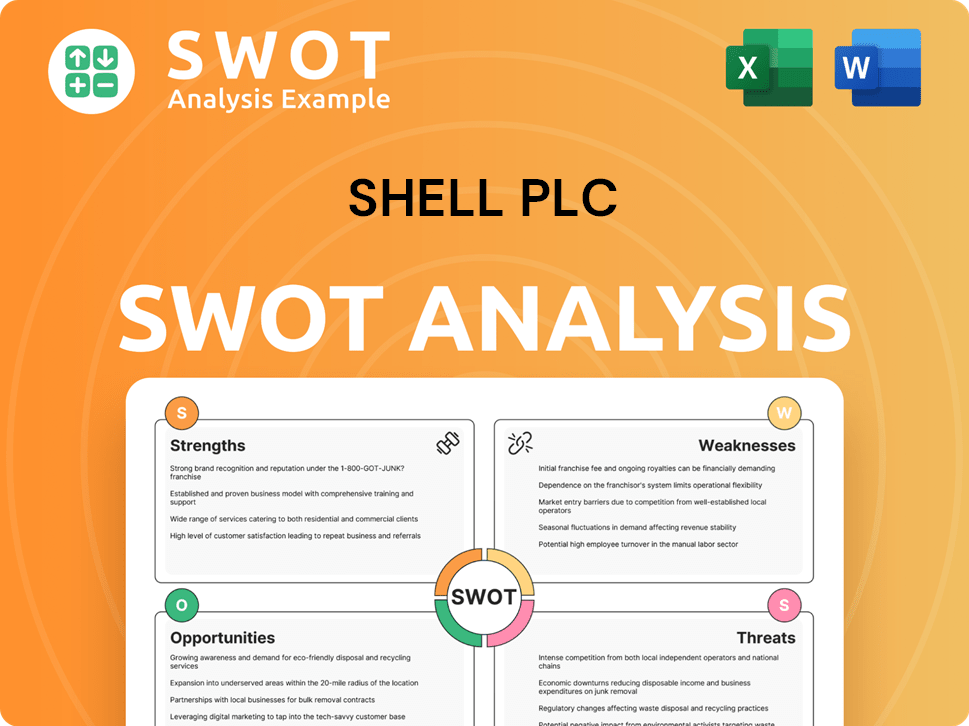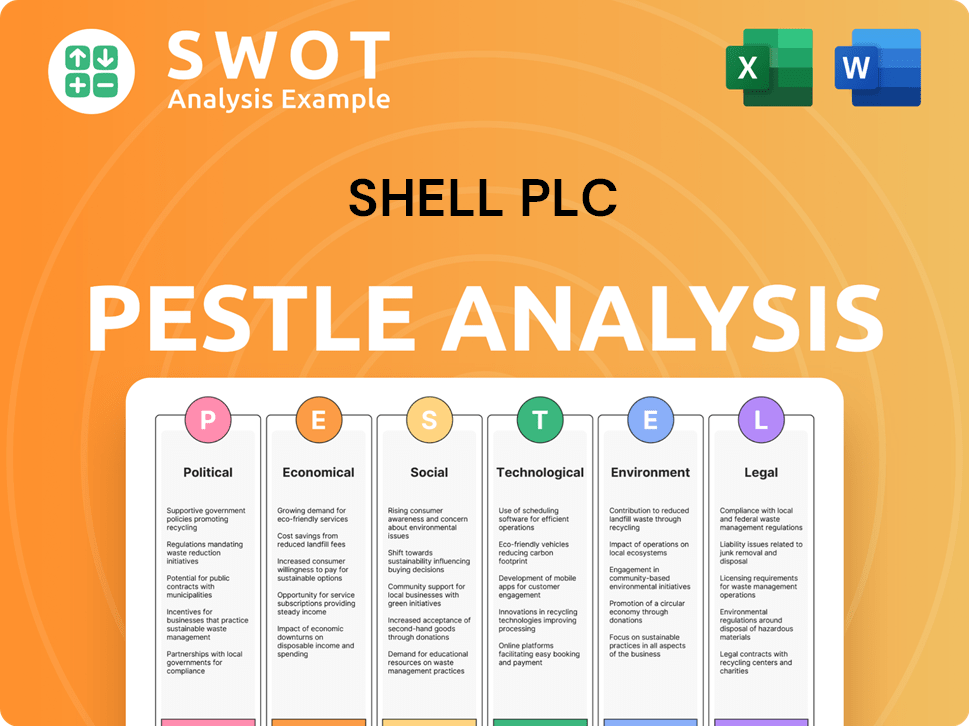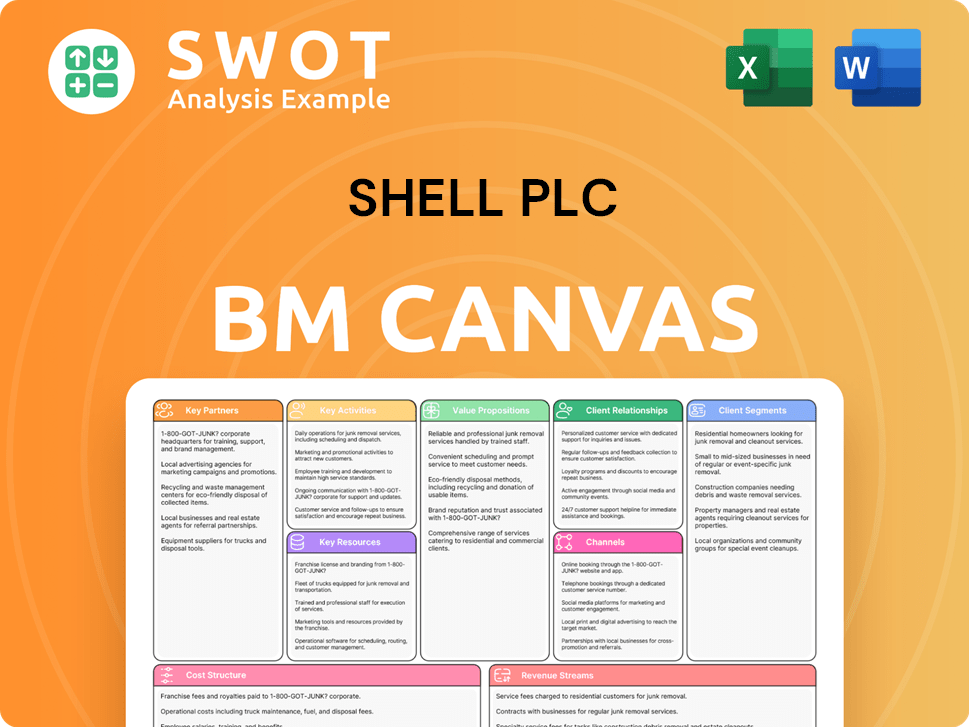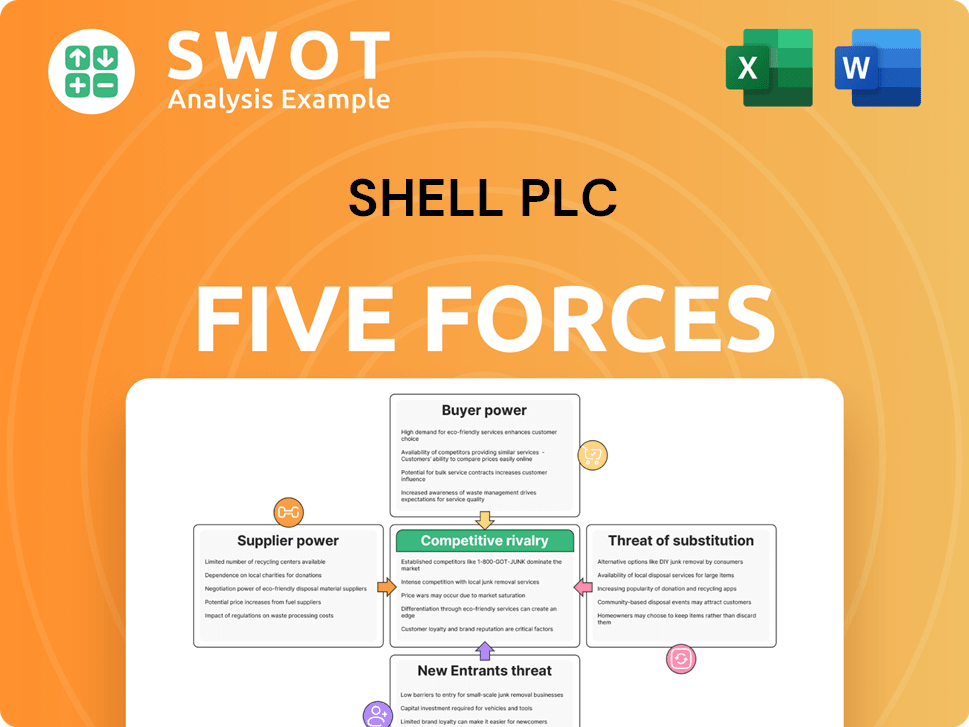Shell Plc Bundle
Can Shell Plc Navigate the Energy Transition and Thrive?
Shell, a titan of the energy sector, is charting a course towards a multi-energy future, but what does this mean for its long-term viability? This in-depth analysis explores Shell's strategic pivot, examining its investments in renewables and lower-carbon technologies. From its origins in the oil and gas industry to its ambitious sustainability goals, discover how Shell Company plans to adapt and lead in a rapidly changing world.

This exploration of Shell Plc SWOT Analysis will uncover Shell's strategic growth initiatives, assessing its expansion plans globally and its response to the energy transition. We'll delve into Shell's financial performance analysis, including its stock price forecast and dividend policy, while considering the company's impact on climate change and its competitive landscape within the Oil and Gas Industry. Understand the future prospects of Shell Plc as it navigates the complexities of the energy sector.
How Is Shell Plc Expanding Its Reach?
As part of its Shell Growth Strategy, Shell Plc is actively pursuing expansion initiatives to diversify its energy portfolio. This strategic move aims to secure future growth, particularly in the low-carbon and renewable energy sectors. These initiatives are designed to access new customer segments and diversify revenue streams away from traditional fossil fuels.
The company is focusing on expanding its integrated power business. The goal is to serve 15 million retail and business customers by 2030, which is a significant increase from its current reach. Shell is also expanding its biofuels production, with plans to increase output to 5 billion liters annually by 2030. These efforts reflect Shell's commitment to adapting to the evolving demands of the Energy Sector.
Geographical expansion is a key element of Shell's strategy. This includes a growing presence in the electric vehicle (EV) charging market, with targets to operate over 200,000 public charge points by 2030. Shell is also exploring new business models, such as carbon capture and storage (CCS) projects, to further its Shell Future Prospects.
Shell is significantly increasing its renewable electricity generation capacity. A notable project is the Hollandse Kust West VI offshore wind farm in the Netherlands, expected to have a capacity of 760 MW. This expansion supports the company's commitment to sustainable energy sources and contributes to its Shell's sustainability goals.
Shell is investing heavily in biofuels production, with plans to increase output to 5 billion liters annually by 2030. The company is also focusing on sustainable aviation fuel (SAF) production. An example is the SAF facility in Rotterdam, which is set to be one of the largest in Europe, demonstrating Shell's proactive approach to reducing carbon emissions.
Shell is rapidly expanding its EV charging network to meet growing demand. The company aims to operate over 200,000 public charge points by 2030. This expansion is driven by the increasing adoption of EVs globally and the need to build out the necessary infrastructure. This is a part of Shell's response to the energy transition.
Shell is investing in carbon capture and storage (CCS) projects to reduce emissions. The Northern Lights project in Norway aims to store CO2 from industrial emitters. These initiatives highlight Shell's commitment to reducing its environmental impact and exploring innovative solutions within the Oil and Gas Industry.
Shell is forming strategic partnerships to expand its market reach and technological capabilities. A notable collaboration is with Porsche to deploy high-power charging facilities. These partnerships enhance Shell's ability to compete in the evolving energy landscape. For more insights, consider exploring the Revenue Streams & Business Model of Shell Plc.
- Collaborations with other companies.
- Expansion into the EV charging market.
- Investment in CCS projects.
- Focus on renewable energy sources.
Shell Plc SWOT Analysis
- Complete SWOT Breakdown
- Fully Customizable
- Editable in Excel & Word
- Professional Formatting
- Investor-Ready Format

How Does Shell Plc Invest in Innovation?
The innovation and technology strategy of Shell Plc is crucial for its growth, focusing on developing and implementing advanced solutions across its traditional and new energy sectors. Shell is heavily investing in research and development (R&D) to achieve breakthroughs in areas like hydrogen production, advanced biofuels, and carbon capture technologies. These efforts are designed to position Shell as a leader in the evolving energy landscape and support its strategic goals, including its sustainability targets.
Shell's digital transformation efforts leverage artificial intelligence (AI) and machine learning to optimize operations, from exploration to refining and retail. This includes predictive maintenance, supply chain optimization, and enhanced customer experiences through digital platforms. Automation, particularly robotic process automation (RPA), is also a key focus for streamlining administrative tasks and improving operational efficiency.
The company is actively exploring the Internet of Things (IoT) to monitor and manage its assets more effectively, enabling real-time data analysis for improved decision-making. This technology-driven approach supports Shell's commitment to sustainability and its transition towards a lower-carbon energy system. This strategy is vital for the future of the company, as discussed in detail in Target Market of Shell Plc.
Shell is investing in next-generation electrolyzer technology for green hydrogen production. This aims to reduce costs and improve efficiency, supporting the company's move towards cleaner energy sources. The company is actively developing and deploying hydrogen production facilities to meet future demand.
Shell uses AI and machine learning to optimize operations, including predictive maintenance and supply chain optimization. Digital platforms enhance customer experiences, supporting efficiency and improving decision-making. This digital focus is essential for streamlining operations and improving customer engagement.
Robotic process automation (RPA) is implemented to streamline administrative tasks and improve efficiency. The Internet of Things (IoT) is used to monitor and manage assets, enabling real-time data analysis. These technologies enhance operational efficiency and support data-driven decision-making.
Shell is developing and commercializing low-carbon energy solutions, including advanced biofuels and renewable energy technologies. This includes advancements in renewable energy solutions, such as more efficient solar panels and wind turbine technologies, and the development of advanced biofuels that can reduce emissions from transportation. These initiatives are central to Shell's sustainability goals.
Shell is significantly investing in R&D to drive breakthroughs in hydrogen production, advanced biofuels, and carbon capture. This investment is crucial for maintaining a competitive edge and achieving long-term growth objectives. Shell's commitment to R&D demonstrates its dedication to innovation.
Shell actively pursues patents in emerging energy technologies to secure competitive advantages. This strategic focus helps Shell to protect its innovations and supports its growth objectives in the evolving energy landscape. This strategy highlights Shell's commitment to innovation.
Shell's technology strategy is multifaceted, encompassing digital transformation, automation, and sustainability initiatives. These initiatives are designed to optimize operations, reduce emissions, and drive growth. The company's investments in these areas are substantial and reflect its commitment to the energy transition.
- Digitalization: Implementing AI and machine learning across the value chain.
- Automation: Using RPA to improve efficiency in administrative and operational tasks.
- Hydrogen: Investing in green hydrogen production technologies.
- Renewables: Developing advanced biofuels and renewable energy solutions.
- Carbon Capture: Exploring and investing in carbon capture technologies.
Shell Plc PESTLE Analysis
- Covers All 6 PESTLE Categories
- No Research Needed – Save Hours of Work
- Built by Experts, Trusted by Consultants
- Instant Download, Ready to Use
- 100% Editable, Fully Customizable

What Is Shell Plc’s Growth Forecast?
The financial outlook for Shell Plc, a major player in the energy sector, is shaped by its strategic pivot towards a balanced energy portfolio. This strategy involves significant investments in lower-carbon solutions while maintaining strong performance in its traditional oil and gas segments. This dual approach is designed to navigate the evolving energy landscape and capitalize on emerging opportunities.
For the full year 2024, analysts' consensus estimates project Shell's revenue to be approximately $300 billion to $320 billion. The adjusted earnings per share (EPS) are anticipated to be in the range of $4.50 to $5.00. These financial projections reflect the company's ongoing efforts to optimize its portfolio and enhance operational efficiencies across its diverse business segments. Shell's financial strategy also involves potential divestments of non-core assets to optimize its portfolio and free up capital for strategic investments in growth areas.
Shell is committed to the energy transition, with plans to allocate 10-15% of its capital expenditure towards its Renewables and Energy Solutions division by 2025. This commitment translates to an annual investment of roughly $2 billion to $3 billion in renewable energy projects. These projects include wind, solar, and EV charging infrastructure, demonstrating Shell's focus on sustainable energy sources. The company aims to deliver robust returns on capital employed (ROCE) across its diverse portfolio, with a target of greater than 10% ROCE for its Renewables and Energy Solutions business by 2030.
Shell's financial performance in 2024 is expected to be strong, with projected revenues between $300 billion and $320 billion. Adjusted EPS is forecasted to be in the range of $4.50 to $5.00, reflecting the company's operational efficiency and strategic investments. These figures indicate Shell's ability to generate substantial earnings despite the ongoing energy transition.
By 2025, Shell plans to allocate 10-15% of its capital expenditure to its Renewables and Energy Solutions division. This commitment translates to approximately $2 billion to $3 billion annually for renewable energy projects. This investment strategy underscores Shell's dedication to expanding its presence in the renewable energy sector.
Shell aims to reduce its net debt to $65 billion, a significant decrease from the $71.7 billion reported as of Q4 2023. This focus on financial discipline is crucial for maintaining a strong balance sheet and supporting future investments. The company's financial strategy also involves potential divestments of non-core assets to optimize its portfolio and free up capital for strategic investments in growth areas.
Shell is targeting a ROCE of greater than 10% for its Renewables and Energy Solutions business by 2030. This target reflects Shell's commitment to generating strong returns from its investments in renewable energy. Historically, the group's ROCE has been around 12-15% in recent years, demonstrating its ability to generate robust returns.
Shell's financial strategy includes potential divestments of non-core assets to optimize its portfolio and free up capital. This approach allows the company to focus on strategic investments in high-growth areas, supporting its long-term business strategy. This strategic move is part of Shell's response to the energy transition.
Shell aims to generate strong cash flow from its Upstream and Integrated Gas businesses. This cash flow will be used to fund growth initiatives in the Renewables and Energy Solutions division. This strategy ensures that Shell can maintain shareholder distributions while investing in future growth. For more details, you can explore the Brief History of Shell Plc.
Shell Plc Business Model Canvas
- Complete 9-Block Business Model Canvas
- Effortlessly Communicate Your Business Strategy
- Investor-Ready BMC Format
- 100% Editable and Customizable
- Clear and Structured Layout

What Risks Could Slow Shell Plc’s Growth?
Navigating the energy transition and maintaining a competitive edge presents several potential risks and obstacles for Shell Plc. These challenges range from market competition and regulatory changes to technological disruption and internal organizational shifts. Successfully addressing these issues is critical for Shell's long-term growth and sustainability within the evolving energy sector.
Shell's strategic growth initiatives and future prospects are significantly influenced by its ability to manage these risks. The company must adapt to fluctuating market conditions, invest in new technologies, and meet rising expectations for environmental, social, and governance (ESG) performance. A proactive approach to risk management is essential for Shell Company to thrive in the dynamic oil and gas industry.
Market competition from established energy companies and emerging renewable energy players intensifies price pressure, potentially reducing Shell's market share. The company faces regulatory changes, including stricter environmental policies and carbon pricing, which increase operational costs and require substantial investment in new technologies. Furthermore, supply chain vulnerabilities and geopolitical instability can disrupt operations, affecting equipment procurement and product delivery.
Stricter environmental regulations and carbon pricing mechanisms increase operational costs. Compliance with these regulations requires significant investment in new technologies and infrastructure. Failure to adapt to these changes could lead to financial penalties and stranded assets.
Rapid advancements in battery storage, hydrogen production, and carbon capture pose both opportunities and risks. Failure to keep pace with these technological advancements could hinder Shell's competitive position. Successfully commercializing new technologies is crucial for future growth.
Geopolitical tensions and global economic instability can disrupt Shell's operations. These disruptions can affect equipment procurement, the delivery of oil and gas products, and the overall efficiency of operations. Diversifying supply chains is crucial for mitigating these risks.
Competition from established energy companies and emerging renewable energy players intensifies price pressure. This competition could reduce Shell's market share in both traditional and new energy markets. Strategic diversification is essential to maintain a competitive edge.
Managing the vast scale of operations and the cultural shift required for the energy transition presents resource constraints. Adapting to new technologies and market demands requires significant organizational changes. Effective leadership and employee training are crucial for success.
Increasing frequency and intensity of extreme weather events can impact physical assets and operations. Climate change also influences investor and public expectations regarding ESG performance. Investing in resilient infrastructure and sustainable practices is essential.
Shell's ability to adapt to these challenges will be key to its long-term success. The company's risk management framework includes diversification of its energy portfolio, scenario planning, and continuous investment in cybersecurity. For example, Shell has adjusted its investment plans in response to market volatility, demonstrating its adaptability. The company's response to the energy transition and its commitment to sustainability will shape its future. For further insights, explore the Competitors Landscape of Shell Plc.
Shell's strategic initiatives include expanding its renewable energy portfolio and investing in electric vehicle charging infrastructure. The company aims to reduce its carbon emissions and increase its focus on sustainable energy sources. These efforts are crucial for adapting to the energy transition and meeting evolving market demands.
Shell's financial performance analysis reveals its ability to adapt to fluctuating oil and gas prices, with investments adjusted accordingly. Maintaining market share in the oil industry while expanding into renewable energy is a key goal. The company's dividend policy and stock price forecast are important indicators of its financial health.
Shell's sustainability goals and its impact on climate change are under increasing scrutiny from investors and the public. The company's exploration and production strategy must align with these goals. The downstream operations overview shows Shell's efforts to reduce its environmental footprint.
Shell's long-term business strategy focuses on adapting to the energy transition and maintaining its competitive position. Analyzing the competitive landscape and understanding Shell's expansion plans globally are essential. The company's response to the energy transition and its ability to innovate will determine its future success.
Shell Plc Porter's Five Forces Analysis
- Covers All 5 Competitive Forces in Detail
- Structured for Consultants, Students, and Founders
- 100% Editable in Microsoft Word & Excel
- Instant Digital Download – Use Immediately
- Compatible with Mac & PC – Fully Unlocked

Related Blogs
- What are Mission Vision & Core Values of Shell Plc Company?
- What is Competitive Landscape of Shell Plc Company?
- How Does Shell Plc Company Work?
- What is Sales and Marketing Strategy of Shell Plc Company?
- What is Brief History of Shell Plc Company?
- Who Owns Shell Plc Company?
- What is Customer Demographics and Target Market of Shell Plc Company?
Disclaimer
All information, articles, and product details provided on this website are for general informational and educational purposes only. We do not claim any ownership over, nor do we intend to infringe upon, any trademarks, copyrights, logos, brand names, or other intellectual property mentioned or depicted on this site. Such intellectual property remains the property of its respective owners, and any references here are made solely for identification or informational purposes, without implying any affiliation, endorsement, or partnership.
We make no representations or warranties, express or implied, regarding the accuracy, completeness, or suitability of any content or products presented. Nothing on this website should be construed as legal, tax, investment, financial, medical, or other professional advice. In addition, no part of this site—including articles or product references—constitutes a solicitation, recommendation, endorsement, advertisement, or offer to buy or sell any securities, franchises, or other financial instruments, particularly in jurisdictions where such activity would be unlawful.
All content is of a general nature and may not address the specific circumstances of any individual or entity. It is not a substitute for professional advice or services. Any actions you take based on the information provided here are strictly at your own risk. You accept full responsibility for any decisions or outcomes arising from your use of this website and agree to release us from any liability in connection with your use of, or reliance upon, the content or products found herein.